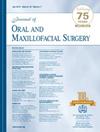Comparing the Infection Rates of Strut Versus Straight Plates in Sagittal Split Osteotomies
IF 2.3
3区 医学
Q2 DENTISTRY, ORAL SURGERY & MEDICINE
引用次数: 0
Abstract
Background
Sagittal split osteotomies can be rigidly fixated through various methods. Unfortunately, infection remains a common postoperative complication.
Purpose
The purpose was to estimate postoperative infection rates between strut and straight plates for internal fixation of sagittal split osteotomies.
Study Design, Setting, Sample
We implemented a retrospective cohort study and included a consecutive series of patients with sagittal split osteotomies performed at the University of Nebraska Medical Center. The cases were performed by a single surgeon with a chief as resident surgeon. Exclusion criteria included any patient with unilateral surgery, mandibular midline osteotomy, previous mandible reconstruction, distraction osteogenesis, previous facial trauma history, and less than 12 weeks of follow-up.
Predictor Variable
Primary predictor variable was plate type (strut vs straight). The choice of plate was not based on the surgical plan.
Main Outcome Variable(s)
The primary outcome variable was postoperative infection. This was defined as purulent discharge, incision and drainage, or prescription of antibiotics. Secondary outcomes include hardware removal and neurosensory function.
Covariates
Covariates included demographics, smoking, alcohol and drug use, single/double jaw, advancement/setback, length of movement, and perioperative third molar extraction.
Analyses
Fisher’s exact test, χ2 test, and Student’s t test were computed to measure bivariate association. The relative risks (RRs) and their 95% CIs were reported. P values < .05 were considered statistically significant.
Results
The sample comprised 112 subjects. There were 51 (45.5%) straight plate and 61 (54.5%) strut plate. There were 32 (62.7%) women in the straight plate group, mean age 25.55 ± 13.34 years and 39 women (63.9%) in the strut plate group, mean age 29.02 ± 11.97 years. Postoperative infection was the most common reason for plate removal (n = 10). Strut plates, relative to straight plates, were associated with a 23% increase (RR 1.23, 95%, CI 0.47 to 2.16, P < .7) in infections, a 25% increase (RR 1.25, 95%, CI 0.45 to 2.27, P < .5) in hardware removal, and a 17% increase (RR 1.17, 95% CI 0.33 to 2.44, P < .7) in postoperative neurosensory disturbance at 3 months for sagittal split osteotomies.
Conclusions and Relevance
The choice of internal fixation plate, strut versus straight, was not associated with postoperative infection, hardware removal, or postoperative neurosensory function deficit.
矢状面劈开截骨术中支板与直板感染率的比较。
背景:矢状面劈开截骨术可通过多种方法进行刚性固定。不幸的是,感染仍然是常见的术后并发症。目的:评估矢状面劈裂截骨术中撑杆钢板与直板内固定的术后感染率。研究设计、背景、样本:我们实施了一项回顾性队列研究,纳入了在内布拉斯加州大学医学中心接受矢状劈裂截骨术的连续系列患者。所有病例均由一名外科医生完成,一名主任担任住院外科医生。排除标准包括任何单侧手术、下颌骨中线截骨、既往下颌骨重建、牵张成骨、既往面部创伤史和随访时间少于12周的患者。预测变量:主要预测变量为板型(支撑型vs直型)。钢板的选择不是基于手术计划。主要结局变量:主要结局变量为术后感染。这被定义为脓性分泌物,切口和引流,或抗生素处方。次要结果包括硬件去除和神经感觉功能。协变量:协变量包括人口统计学、吸烟、酒精和药物使用、单/双颌、前进/后退、活动长度和围手术期第三磨牙拔牙。分析:采用Fisher精确检验、χ2检验和Student’st检验来衡量双变量相关性。报告了相对危险度(RRs)及其95% ci。结果:样本共112例,其中直板51例(45.5%),支撑板61例(54.5%)。直板组32例(62.7%),平均年龄25.55±13.34岁;撑板组39例(63.9%),平均年龄29.02±11.97岁。术后感染是钢板取出的最常见原因(n = 10)。撑杆钢板与直板相比,增加23% (RR 1.23, 95%, CI 0.47 - 2.16, P)。结论及相关性:撑杆钢板与直板内固定钢板的选择与术后感染、硬体移除或术后神经感觉功能缺损无关。
本文章由计算机程序翻译,如有差异,请以英文原文为准。
求助全文
约1分钟内获得全文
求助全文
来源期刊

Journal of Oral and Maxillofacial Surgery
医学-牙科与口腔外科
CiteScore
4.00
自引率
5.30%
发文量
0
审稿时长
41 days
期刊介绍:
This monthly journal offers comprehensive coverage of new techniques, important developments and innovative ideas in oral and maxillofacial surgery. Practice-applicable articles help develop the methods used to handle dentoalveolar surgery, facial injuries and deformities, TMJ disorders, oral cancer, jaw reconstruction, anesthesia and analgesia. The journal also includes specifics on new instruments and diagnostic equipment and modern therapeutic drugs and devices. Journal of Oral and Maxillofacial Surgery is recommended for first or priority subscription by the Dental Section of the Medical Library Association.
 求助内容:
求助内容: 应助结果提醒方式:
应助结果提醒方式:


